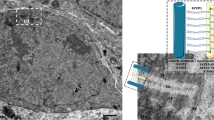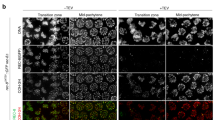Abstract
AT the present time the only chromosomal element which is readily identifiable on electron microscopic examination is the “synaptinemal complex”1 of the male primary spermatocyte. In the course of a study of the mode of attachment of this structure to the nuclear membrane in a variety of mammals, we noted that, in the mouse, two distinct types of endings were seen near the point of attachment. In one type the bivalent appeared to be condensed around the synaptinemal complex to form a heterochromatic “basal knob”2 while, at the other type of ending, the complex was not surrounded by condensed material. The appearances are shown in the electron micrograph (Fig. 1) in which, by a fortunate chance, the entire length of the synaptinemal complex of a bivalent is seen in one section. Since it is now generally agreed that the mitotic chromosomes of the mouse are telocentric with truly terminal centromeres3,4 and the heterochromatic regions of mouse spermatogenial autosomes are thought to be located adjacent to the loci of the kinetochores5, there seems to be justification for identifying the attachment labelled A in Fig. 1 with the centromeric end of the pachytene chromosome and that labelled B with the distal end.
This is a preview of subscription content, access via your institution
Access options
Subscribe to this journal
Receive 51 print issues and online access
$199.00 per year
only $3.90 per issue
Buy this article
- Purchase on Springer Link
- Instant access to full article PDF
Prices may be subject to local taxes which are calculated during checkout
Similar content being viewed by others
References
Moses, M. M., J. Cell. Biol., 2, 215 (1956).
Woollam, D. H. M., and Ford, E. H. R., J. Anat. Lond., 98, 163 (1964).
Ford, E. H. R., and Woollam, D. H. M., Exp. Cell Res., 32, 320 (1963).
Levan, A., Fredga, K., and Sandberg, A. A., Hereditas, 52, 201 (1964).
Ohno, S., Kaplan, W. D., and Kinosita, R., Exp. Cell Res., 13, 358 (1957).
Author information
Authors and Affiliations
Rights and permissions
About this article
Cite this article
WOOLLAM, D., MILLEN, J. & FORD, E. Points of Attachment of Pachytene Chromosomes to the Nuclear Membrane in Mouse Spermatocytes. Nature 213, 298–299 (1967). https://doi.org/10.1038/213298a0
Issue Date:
DOI: https://doi.org/10.1038/213298a0
This article is cited by
-
Structural basis of meiotic telomere attachment to the nuclear envelope by MAJIN-TERB2-TERB1
Nature Communications (2018)
-
Super-resolution microscopy reveals LINC complex recruitment at nuclear indentation sites
Scientific Reports (2014)
-
Kinetochores of grasshoppers with Robertsonian chromosome fusions
Chromosoma (1978)
-
Superchromosomal organization and its cytogenetic consequences in the Eukaryota
Genetica (1978)
-
Karyotype analysis ofAscaris lumbricoides var.suum
Chromosoma (1976)
Comments
By submitting a comment you agree to abide by our Terms and Community Guidelines. If you find something abusive or that does not comply with our terms or guidelines please flag it as inappropriate.



